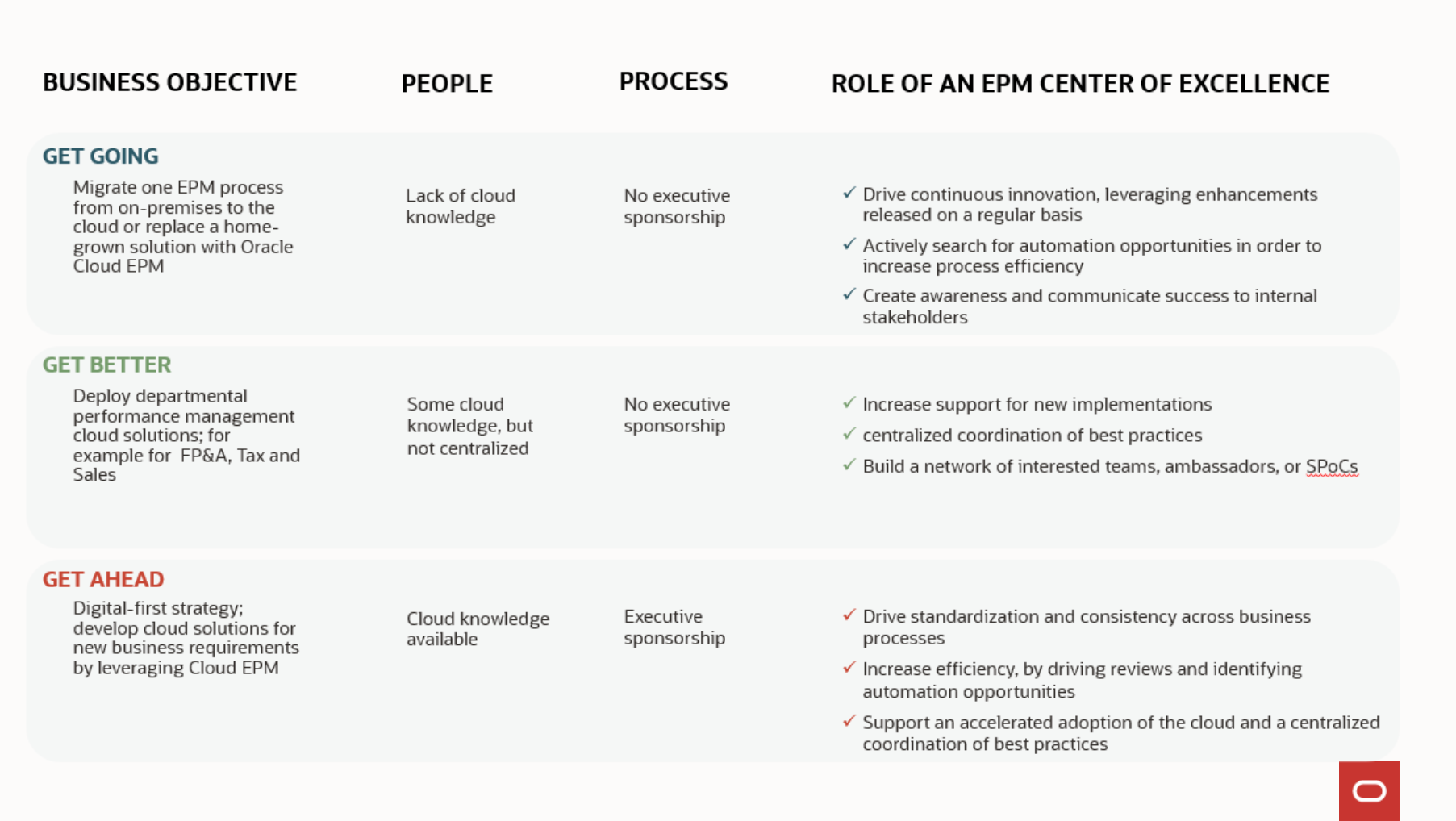Why Do I Need an EPM CoE?
For organizations that have a digital-first strategy, creating a Center of Excellence specifically for EPM is a logical extension of their cloud strategy. It will also help mitigate risk in their cloud adoption and process transformation efforts. If you are a project owner, an EPM CoE will help you deliver efficiently and consistently.
On the other hand, for organizations that are migrating their first on-premises performance management applications to the cloud, the EPM CoE helps drive continuous innovation. It looks for opportunities to increase process efficiency, creates awareness, and communicates success to internal stakeholders.
Earlier BCG research showed that 70% of digital transformations fall short of their goals. It is important to understand how to transition successfully to the cloud, and that is why Oracle is publishing this guide.
According to Gartner, "To ensure cloud adoption success, organizations must have the right skills and structure in place. The optimal way to achieve this is by setting up a centralized cloud center of excellence (CCOE)".
This guide describes best practices and a structured approach to help your organization successfully adopt EPM Cloud by leveraging a CoE.
The results achieved depend on a company's goals, the mode of working (centralized or decentralized), and the organization’s cloud maturity.
Some factors that determine an organization's cloud maturity are:
- People, and the knowledge that employees gain over time as they start working with cloud applications.
-
In organizations with a digital-first strategy, we have shared the checklist to help you create an EPM center of excellence. Of course, if you have already have a cloud center of excellence (CCoE), you can leverage their expertise as well.
- But not all companies are the same. For example, if you are just starting with your first migration of an on-premises performance management application to the cloud, you should consider:
- Building the team – although some organizations decide to do a lift and shift, many are taking the opportunity to get feedback on what enhancements to deliver with the new cloud application and have single points of contact (SPoCs) in different teams
- Planning meetings and communications
- Training and readiness
- Change management
- Establishing milestones
- Measuring success
-
- Process. Organizations across the globe are looking at enhancing their reporting capabilities to cover new requirements from regulators and suppliers, or to address new guidelines for environmental, social, and governance (ESG) reporting.
- To deliver all that, some organizations decide to go through a Finance transformation initiative, which we call top-down because it typically has an executive sponsor. Besides the known project management steps, it's important to emphasize change management and planning the roadmap.
- On the other hand, organizations can start implementing Cloud EPM in one of the business units as a proof of concept for the cloud, and we call that a bottom-up approach. In this case, besides the typical project management steps, emphasis should be put on creating awareness and communicating to internal stakeholders.
- Technology. Organizations typically have either on-premises or cloud performance management applications, or they run a hybrid environment, meaning a mix of on-premises and cloud applications.
This graphic shows some examples of organizations with different maturity levels, and how an EPM CoE can support their evolution and transformation.

Overall, creating an EPM Cloud CoE helps you:
- Accelerate cloud adoption and end-user buy-in
- Maximize efficiency (such as the time to prepare a budget) and effectiveness (for example, tax savings)
- Establish key reporting metrics, best practices, and consistency
- Raise awareness and enable adoption of EPM best practices, such as scenario-based planning and the use of operational data in financial decisions
- Improve agility and flexibility in development and support
- Organize, consolidate, and grow EPM Cloud skill and expertise
- Build lasting capabilities and protect your investment with consistency and governance
To improve the process of digital transformation, Oracle teamed up with the Association of International Certified Professional Accountants (AICPA), the world’s largest accounting member organization. This effort:
- Identified the traits of "agile finance leaders," executives who drive finance transformation at their organizations. The research revealed that 81% of these leaders had created centers of excellence around key modern finance initiatives, such as financial planning and analysis, compared to just 56% of the other finance leaders. Learn more: Analytics in Action: Why Finance Centers of Excellence Make a Difference. Read the ebook to discover five ways to connect and improve planning across the enterprise.
- Created a first-of-its-kind training, The Agile Finance Transformation Certificate Series. This training is designed to help finance professionals successfully transition to the cloud and drive better business results while accelerating their career.
When creating an EPM CoE, your organization should follow a strategy that leverages experience-based recommendations for people, processes, and technology, with a phased approach to cloud transformation. As AICPA points out, this prepares you to succeed with your own finance transformation.
Use this guide and the EPM CoE as a navigation system that steers your organization through changes and points you to relevant technical information. This guide also provides examples that the CoE can leverage for building consensus and for internal communications to stakeholders.
Learn More
-
Understand the business benefits and value proposition of an EPM CoE.
-
Read the Value of EPM survey.